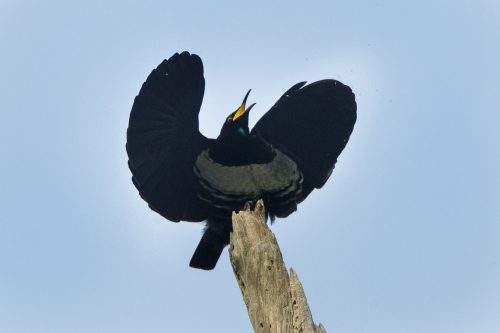The evolution of super-black feathers in birds-of-paradise
Just like a teenager before a first date, male birds-of-paradise spend hours checking their looks and practicing their dance moves. But unlike a teenager, who might change clothes five times before leaving the house, male birds-of-paradise wear the same outfit their whole life—so they make it as flashy as possible. Their plumage is astonishingly black, much more so than any tuxedo. A new study by Yale researchers Todd Harvey and Richard Prum examined what causes the velvety, super-black quality in the feathers of these birds.
Understanding the processes behind bird coloration is important to understand evolution, sexual selection, and speciation. Birds-of-paradise have some of the most intricate courtship dances and feather coloration in the world, making them ideal to study. The researchers hypothesized that the birds’ super-black feathers evolved to intensify the perceived brightness of neighboring colorful feather patches, appealing more to females during the courtship dance.
Two processes contribute to bird feather coloration. Molecular-level pigments absorb light only at specific wavelengths, reflecting the rest to produce color. The second process, known as structural absorption, generates color by scattering light at multiple angles. In both cases, we see the reflected light as color. A material that reflects all light will appear white, and a material that absorbs all light will look black.
The researchers discovered that the birds’ super-black color comes from this second process of structural absorption. When light is scattered, the feather absorbs some of that scattered light. By causing more scattering, structurally absorbent objects like bird feathers can take in more light and appear much darker. Bird-of-paradise feathers look so black because they are essentially trapping all the light.
The researchers studied the function of this structural absorption in feathers from seven different bird-of-paradise species. They discovered that super-black feathers structurally absorbed 99.95% of incoming light, the most efficient rate of any natural material. The shape, position, and texture of feather barbs and barbules, hook-like structures holding the feather together, all affect the coloration. The experimenters found that the barbule arrays of super-black feathers tilted vertically, forming deep and curved structural cavities.
The scientists hypothesized that the tilted feather microstructure, combined with the courtship dance, evolved to elevate vibrant feathers to their maximal brilliance. In both butterflies and birds-of-paradise, super-black areas are located next to structurally colorful feathers. The super-black feathers make other colors appear brighter by eliminating the environmental signals females typically use to judge color intensity. Specifically, they override specular highlights, the spots of light that show up on illuminated shiny objects, and define physical boundaries. The feathers absorb all the incident light, making the neighboring colors seem so radiant they lose their boundaries and hover in space.
The researchers also found that super-black feathers have a strong directional reflectance bias, making them look darkest when facing a viewer head on. Male birds-of-paradise strut their stuff at a particular angle relative to watchful females, consistent with the optimal angle for a super-black appearance.
However, only feathers used in the courtship dance were super-black. Other feathers such as those on the birds’ backs, reflected more light. The difference in structure and color between feathers involved in the courtship dance and those that are not was striking, suggesting a highly specialized purpose. “Other organisms that evolved super-black, a West African viper, or a butterfly…in both cases they evolve this super-black material for a different purpose than our birds-of-paradise,” said Harvey. “Our birds-of-paradise are not developing it for camouflage… they’re developing it because it makes them shockingly beautiful to a mate.”
But much research remains to understand in what ways structural absorption and multiple scattering of light affect the female birds’ color correction. Moving forward, Prum’s lab will likely focus on how female birds-of-paradise perceive a male’s plumage during a courtship dance. Furthermore, the researchers hope that super-black feathers will inspire new biomimetic materials. Structural absorption has major potential for a variety of mechanical, thermal, and solar technologies, like the lining inside space telescopes. Perhaps, like a male bird-of-paradise, the next batch of space photography will blind us with its beauty.
References
[1] Interview with Todd Harvey, postdoctoral associate in Yale’s Department of Ecology and Evolutionary Biology, interview on 1/29/18
[2] “Structural absorption by barbule microstructures of super black bird of paradise feathers,” Dakota E. McCoy, Teresa Feo, Todd Harvey, Richard Prum, Communications, 2018 [https://www.nature.com/articles/s41467-017-02088-w]

